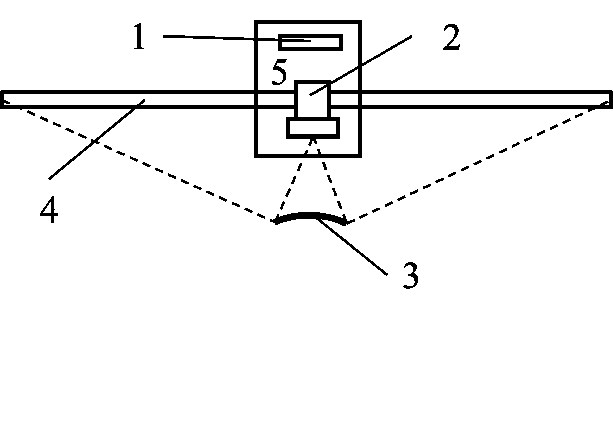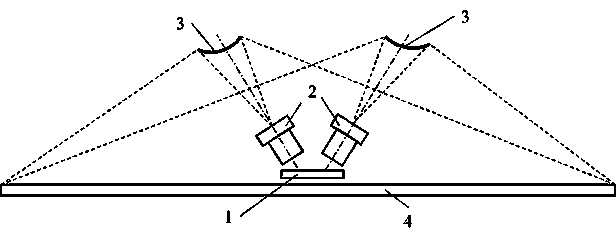Large-field-angle detection image acquisition method for electronic white board and device
A technology for electronic whiteboard and image detection, applied in image communication, TV, color TV and other directions, can solve the problems of the decline of system anti-interference ability, the inability to achieve band-pass filtering, the reduction of whiteboard resolution, etc., to improve the band-pass filter. effect, improve pixel utilization, avoid the effect of edge brightness attenuation
- Summary
- Abstract
- Description
- Claims
- Application Information
AI Technical Summary
Problems solved by technology
Method used
Image
Examples
Embodiment 1
[0031] A method for acquiring an image of an electronic whiteboard with a large field of view image detection in this embodiment comprises the following steps:
[0032] a. Use a lens with a long focal length and an image sensor to form a camera with a small field of view;
[0033] b. Place a convex mirror at a certain distance in front of the lens of the camera, and make it within the viewing range of the camera;
[0034] c. Select the appropriate shape parameters of the convex mirror and adjust the orientation and angle of the camera and the convex mirror, so that the whiteboard space to be photographed is reflected and imaged on the image sensor of the camera through the convex mirror. Such as figure 1 , figure 2 shown. figure 1 , figure 2 The basic application of the method is illustrated, figure 1 is the side view, figure 2 is a top view. Among them: image sensor 1, lens 2, convex mirror 3, whiteboard 4, lens 2 is a lens with a long focal length, and it togeth...
Embodiment 2
[0036] Such as image 3 Shown is a schematic diagram of the principle of this embodiment. The electronic whiteboard image acquisition method of large field of view image detection adopts two long focal length lenses so that the optical axis is at a certain angle, and there is a convex mirror at a certain distance in front of each lens, so that the whiteboard space to be photographed passes through two sets of convex mirrors and The lenses simultaneously image images on the same image sensor.
[0037] Although most related products currently use a single camera for image acquisition to realize the electronic whiteboard, there are also technical solutions that require two cameras for image acquisition from different directions, and coordinate information is obtained by cross calculation. Usually, two cameras are separated by a certain distance to collect images on the same whiteboard space, but this method has the following problems: 1. The connection of two digital cameras inc...
Embodiment 3
[0039] Such as Figure 4 Shown is a schematic diagram of the principle of this embodiment. The image acquisition method of the large field of view image detection electronic whiteboard in this embodiment introduces one or two small mirrors, which are arranged close to the surface of the image sensor, so that the light of the corresponding long focal length lens is reflected to the surface through the small mirrors. the image sensor. In the previous embodiment image 3 In the case shown, in order to achieve a large distance between the two convex mirrors, the angle between the optical axes of the two lenses needs to be large, but if the angle between the optical axes of the two lenses is too large, the rays of light from both will be large It is disadvantageous that the surface of the sensor 1 is irradiated obliquely. To solve this problem, one can Figure 4 Similarly, the image sensor is basically perpendicular to the optical axis of one of the lenses, and the other light ...
PUM
 Login to View More
Login to View More Abstract
Description
Claims
Application Information
 Login to View More
Login to View More - R&D
- Intellectual Property
- Life Sciences
- Materials
- Tech Scout
- Unparalleled Data Quality
- Higher Quality Content
- 60% Fewer Hallucinations
Browse by: Latest US Patents, China's latest patents, Technical Efficacy Thesaurus, Application Domain, Technology Topic, Popular Technical Reports.
© 2025 PatSnap. All rights reserved.Legal|Privacy policy|Modern Slavery Act Transparency Statement|Sitemap|About US| Contact US: help@patsnap.com



